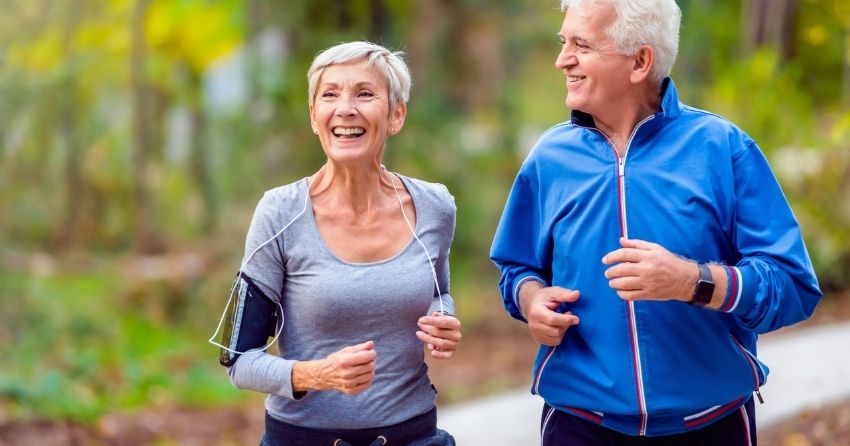Aerobics and Autophagy: How Exercise Supports Heart Health and Cellular Recycling Processes in Later Life

The incidence of poor heart health increases markedly with age, jumping from 20% of 45-year-olds to 90% of adults once they reach age 80. Precipitating this decline in cardiac function are several breakdowns in cellular mechanisms, including a loss of protein quality control, damage to our cells’ energy powerhouses — the mitochondria — and a drop in autophagy.
Meaning "self-eating" in Greek, autophagy is a natural, regulated internal mechanism that removes unnecessary or damaged cells or cell parts. Without autophagy, dysfunctional or toxic cells and proteins accumulate and increase the risk of age-related bodily decline. With advancing age, our autophagic abilities drop progressively in all organs and tissues, including the heart. Growing amounts of research aim to determine how to boost autophagy to slow down this highly prevalent cardiac aging — and one way to do so could be with aerobic exercise, as a recent study published in Aging Cell uncovers. Authored by Cho and colleagues, this research shows that these simple lifestyle changes may be a feasible way to prevent the typical age-related drop in cardiac autophagy — and with it, support cardiovascular health as we reach our 60s and beyond.

Aging and Autophagy
Because our heart muscle cells have limited ability to grow and divide, they are particularly reliant on autophagy to maintain proper function. Our hearts’ autophagic capacities commonly drop with age, leading to poor heart and vascular function. While thousands of studies have demonstrated the beneficial health effects of exercise, this is the first to examine how late-life physical activity impacts cardiac autophagy and mitochondrial health in aged mice.
In this recent study, Cho and colleagues compared various markers of cardiac health in older versus younger mice. As expected, the older mice displayed significantly reduced autophagy, as measured by several proteins. These aged mice also had an excessive accumulation of protein clumping — a common characteristic of aging and age-related disease — and oxidative stress, a buildup of inflammatory compounds called reactive oxygen species (ROS). Plus, the aged mice exhibited signs of impaired cardiac and vascular function, as seen by thickened heart walls, scarring, and low ability to pump blood.
All of these detrimental changes to the heart were expected in these older animals. But Cho and colleagues aimed to see whether regular aerobic exercise, using a progressive resistance treadmill regimen, could ameliorate these concerns — and it did.
How Exercise Helps Cells Take Out the Trash
As autophagy is a highly dynamic process, the term ‘autophagic flux’ is often used to assess its ever-changing state. One aspect of this flux state is the formation of autophagosomes — sac-like membranes that resemble the garbage bag containing the cellular trash in this recycling scenario. From there, the autophagosomal garbage bag and its contents get transported to the lysosome, which could be considered the recycling center. This process requires the protein LC3, which is often used as a proxy for autophagic status. As inadequate autophagosome formation contributes to accelerated cardiac aging, Cho and colleagues aimed to see if exercise could better support this process.
In this study, older mice aged 21 to 24 months (about 65 to 70 in human years) who exercised on the treadmill saw improvements in these autophagic processes. The hearts of the older mice who exercised had boosted activity of several proteins, including LC3, indicating that trafficking of the autophagosome to the lysosome (i.e., taking the trash out) was increased. This strongly supports the notion that the otherwise-repressed autophagic flux seen with aging can be restored by aerobic exercise later in life.

Harnessing a Healthier Heart
These improvements in autophagy then correlated with positive changes to cardiac function, mitochondrial quality, and proper protein balance. While the older sedentary mice had high levels of oxidative stress and aggregated proteins, the exercising mice showed the opposite. Plus, the aerobic exercise led to the restored activity of two genes involved with mitochondrial function, Pink1 and Park2, suggesting a greater ability to clear out excessive and harmful ROS. All in all, each age-associated cardiac and cellular disruption was lessened in the exercising mice.
As autophagy is a non-negotiable part of being a healthy human — or mouse — the results from this study exemplify how simple lifestyle changes, like regular exercise, can support this process throughout life. Although declining heart health is a complex and multifactorial condition, one driving force behind many of its characteristics, including excessive ROS and poor mitochondrial function, is inadequate autophagy.
There are many purported ways to boost autophagy — caloric restriction, intermittent fasting, and plant-based compounds like resveratrol and spermidine, to name a few. However, it appears that one of the most feasible (and cheapest) ways to support both autophagy and heart health with age may be to simply lace up your tennis shoes and hit the pavement — or treadmill.
References:
Cho JM, Park SK, Ghosh R, et al. Late-in-life treadmill training rejuvenates autophagy, protein aggregate clearance, and function in mouse hearts [published online ahead of print, 2021 Sep 23]. Aging Cell. 2021;e13467. doi:10.1111/acel.13467
Zhang XJ, Chen S, Huang KX, Le WD. Why should autophagic flux be assessed?. Acta Pharmacol Sin. 2013;34(5):595-599. doi:10.1038/aps.2012.184







